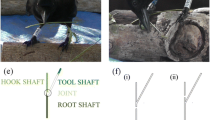Abstract
New Caledonian crows are the most proficient non-hominin tool manufacturers but the cognition behind their remarkable skills remains largely unknown. Here we investigate if they attend to the functional properties of the tools that they routinely use in the wild. Pandanus tools have natural barbs along one edge that enable them to function as hooking implements when the barbs face backwards from the working tip. In experiment 1 we presented eight crows with either a non-functional (‘upside-down’) or a functional pandanus tool in a baited hole. Four of the crows never flipped the tools. The behaviour of the four flipping birds suggested that they had a strategy of flipping a tool when it was not working. Observations of two of the eight crows picking up pandanus tools at feeding tables in the wild supported the lack of attention to barb direction. In experiment 2 we gave six of the eight crows a choice of either a barbed or a barbless pandanus tool. Five of the crows chose tools at random, which further supported the findings in experiment 1 that the crows paid little or no attention to the barbs. In contrast, a third experiment found that seven out of eight crows flipped non-functional stick tools significantly more than functional ones. Our findings indicate that the crows do not consistently attend to the presence or orientation of barbs on pandanus tools. Successful pandanus tool use in the wild seems to rely on behavioural strategies formed through associative learning, including procedural knowledge about the sequence of operations required to make a successful pandanus tool.







Similar content being viewed by others
References
Bender R, Lange S (2001) Adjusting for multiple testing: when and how? J Clin Epidemiol 54:343–349
Boesch C, Boesch H (1990) Tool use and making in wild chimpanzees. Folia Primatol 54:86–99
Chappell J, Kacelnik A (2002) Tool selectivity in a non-primate, the New Caledonian crow (Corvus moneduloides). Anim Cogn 5:1–17
Chappell J, Kacelnik A (2004) Selection of tool diameter by New Caledonian crows (Corvus moneduloides). Anim Cogn 7:121–127
Eibl-Eibesfeldt I (1961) Ueber den Werkzeuggebrauch des Spechtfinken Camarhynchus pallidus (Slater und Slavin). Z Tierpsychol 18:343–346
Emery NJ, Clayton NS (2004) Comparing the complex cognition of birds and primates. In: Rogers LJ, Kaplan G (eds) Comparative vertebrate cognition: are primates superior to non-primates? Kluwer/Plenum, Dordrecht/New York, pp 3–55
Goodwin D (1986) Crows of the world. British Museum (Natural History) Press, London
Hauser MD, Kralik J, Botto-Mahan C (1999) Problem solving and functional design features: experiments on cotton-top tamarins (Saguinus oedipus). Anim Behav 57:565–582
Hauser MD, Pearson H, Seelig D (2002) Ontogeny of tool use in cotton-top tamarins, Saguinus oedipus: innate recognition of functionally relevant features. Anim Behav 64:299–311
Hunt GR (1996) Manufacture and use of hook-tools by Caledonian crows. Nature 397:249–251
Hunt GR, Gray RD (2002) Species-wide manufacture of stick-type tools by New Caledonian Crows. Emu 102:349–353
Hunt GR, Gray RD (2003) Diversification and cumulative evolution in New Caledonian crow tool manufacture. Proc R Soc Lond B 270:867–874
Hunt GR, Gray RD (2004a) The crafting of hook tools by wild New Caledonian crows. Proc R Soc Lond B 271(suppl):S88–S90
Hunt GR, Gray RD (2004b) Direct observations of pandanus-tool manufacture and use by a New Caledonian crow (Corvus moneduloides). Anim Cogn 7:114–120
Hunt GR, Gray RD (2007) Parallel tool industries in New Caledonian crows. Biology Letters 3:173–175
Kenward B, Weir AAS, Rutz C, Kacelnik A (2005) Tool manufacture by naive juvenile crows. Nature 433:121
Kenward B, Rutz C, Weir AAS, Kacelnik A (2006) Development of tool use in New Caledonian crows: inherited action patterns and social influences. Anim Behav 72:1329–1343
Limongelli L, Boysen ST, Visalberghi E (1995) Comprehension of cause-effect relations in a tool-using task by chimpanzees (Pan troglodytes). J Comp Psychol 109:18–26
Millikan GC, Bowman RI (1967) Observations on Galapagos tool-using finches in captivity. Living Bird 6:23–41
Mulcahy N, Call J (2006) How great apes perform on a modified trap-tube task. Anim Cogn 9:193–199
Penn DC, Povinelli DJ (2007) Causal cognition in human and nonhuman animals: a comparative, critical review. Ann Rev Psychol 58:97–118
Povinelli DJ (2000) Folk physics for apes: a chimpanzee’s theory of how the world works. Oxford University Press, Oxford
Santos L, Miller C, Hauser MD (2003) Representing tools: how two non-human primate species distinguish between the functionally relevant and irrelevant features of a tool. Anim Cogn 6:269–281
Santos L, Pearson H, Spaepen G, Tsao F, Hauser M (2006) Probing the limits of tool competence: experiments with two non-tool-using species (Cercopithecus aethiops and Saguinus oedipus). Anim Cogn 9:94–109
Seed AM, Tebbich S, Emery NJ, Clayton NS (2006) Investigating physical cognition in rooks, Corvus frugilegus. Curr Biol 16:697–701
Silva FJ, Page DM, Silva KM (2005) Methodological–conceptual problems in the study of chimpanzees’ folk physics: how studies with adult humans can help. Learn Behav 33:47–58
Tebbich S, Bshary R (2004) Cognitive abilities related to tool use in the woodpecker finch, Cactospiza pallida. Anim Behav 67:689–697
Tebbich S, Seed A, Emery NJ, Clayton NS (2007) Non-tool-using rooks Corvus frugilegus solve the trap-tube task. Anim Cogn 10:225–231
Visalberghi E, Limongelli L (1994) Lack of comprehension of cause-effect relations in tool-using capuchin monkeys (Cebus apella). J Comp Psychol 108:15–22
Visalberghi E, Fragaszy DM, Savage-Rumbaugh S (1995) Performance in a tool-using task by common chimpanzees (Pan troglodytes), bonobos (Pan paniscus), an orangutan (Pongo pygmaeus), and capuchin monkeys (Cebus apella). J Comp Psychol 109:52–60
Weir AAS, Kacelnik A (2006) A New Caledonian crow (Corvus moneduloides) creatively re-designs tools by bending or unbending aluminium strips. Anim Cogn 9:317–334
Weir AAS, Chappell J, Kacelnik A (2002) Shaping of hooks in New Caledonian crows. Science 297:981
Yamamoto K, Furuya I, Watanabe S (2001) Near-field visual acuity in Japanese jungle crows (Corvus macrorhynchos). Physiol Behav 72:283–286
Acknowledgments
We thank William Wadrobert for kindly allowing us to work on his family’s land in Wabao District, Maré. Daniel Houmbouy (Province des Iles Loyauté) gave us permission to work on Maré. Mick Sibley prepared DVD versions of the footage and constructed the aviary. Michael Anderson and Mick Sibley assisted with the data collection. We thank Alex Taylor and Roland Rehm for comments on earlier drafts and Alex Weir and three anonymous referees for detailed comments on the submitted manuscript. Felipe Medina helped to improve the figures. We thank Gilles Dagostini (I.R.D., Nouméa) for identifying Olea paniculata. This research was funded by a grant from the New Zealand Marsden Fund (R.D.G. and G.R.H.). The research reported in this paper was approved by the University of Auckland Animal Ethics committee (approval # R375) and complies with the laws of New Caledonia.
Author information
Authors and Affiliations
Corresponding author
Electronic supplementary material
Below is the link to the electronic supplementary material.
(WMV 693 kb)
Rights and permissions
About this article
Cite this article
Holzhaider, J.C., Hunt, G.R., Campbell, V.M. et al. Do wild New Caledonian crows (Corvus moneduloides) attend to the functional properties of their tools?. Anim Cogn 11, 243–254 (2008). https://doi.org/10.1007/s10071-007-0108-1
Received:
Revised:
Accepted:
Published:
Issue Date:
DOI: https://doi.org/10.1007/s10071-007-0108-1




